ZHCSEI4C July 2012 – January 2016 LMK04816
PRODUCTION DATA.
- 1 特性
- 2 应用
- 3 说明
- 4 修订历史记录
- 5 Pin Configuration and Functions
- 6 Specifications
- 7 Parameter Measurement Information
-
8 Detailed Description
- 8.1
Overview
- 8.1.1 System Architecture
- 8.1.2 PLL1 Redundant Reference Inputs (CLKin0/CLKin0*, CLKin1/CLKin1*, and CLKin2/CLKin2*)
- 8.1.3 PLL1 Tunable Crystal Support
- 8.1.4 VCXO and CRYSTAL-Buffered Outputs
- 8.1.5 Frequency Holdover
- 8.1.6 Integrated Loop Filter Poles
- 8.1.7 Internal VCO
- 8.1.8 External VCO Mode
- 8.1.9 Clock Distribution
- 8.1.10 0-Delay
- 8.1.11 Default Start-Up Clocks
- 8.1.12 Status Pins
- 8.1.13 Register Readback
- 8.2 Functional Block Diagram
- 8.3
Feature Description
- 8.3.1 Serial MICROWIRE Timing Diagram
- 8.3.2 Advanced MICROWIRE Timing Diagrams
- 8.3.3 Inputs and Outputs
- 8.3.4 Input Clock Switching
- 8.3.5 Holdover Mode
- 8.3.6 PLLs
- 8.3.7 Status Pins
- 8.3.8 VCO
- 8.3.9
Clock Distribution
- 8.3.9.1 Fixed Digital Delay
- 8.3.9.2
Clock Output Synchronization (SYNC)
- 8.3.9.2.1 Effect of SYNC
- 8.3.9.2.2 Methods of Generating SYNC
- 8.3.9.2.3 Avoiding Clock Output Interruption due to SYNC
- 8.3.9.2.4 SYNC Timing
- 8.3.9.2.5
Dynamically Programming Digital Delay
- 8.3.9.2.5.1 Absolute versus Relative Dynamic Digital Delay
- 8.3.9.2.5.2 Dynamic Digital Delay and 0-Delay Mode
- 8.3.9.2.5.3 SYNC and Minimum Step Size
- 8.3.9.2.5.4 Programming Overview
- 8.3.9.2.5.5 Internal Dynamic Digital Delay Timing
- 8.3.9.2.5.6 Other Timing Requirements
- 8.3.9.2.5.7 Absolute Dynamic Digital Delay
- 8.3.9.2.5.8 Relative Dynamic Digital Delay
- 8.3.10 0-Delay Mode
- 8.4 Device Functional Modes
- 8.5 Programming
- 8.6
Register Maps
- 8.6.1 Register Map and Readback Register Map
- 8.6.2 Default Device Register Settings After Power On Reset
- 8.6.3
Register Descriptions
- 8.6.3.1
Registers R0 to R5
- 8.6.3.1.1 CLKoutX_Y_PD, Powerdown CLKoutX_Y Output Path
- 8.6.3.1.2 CLKoutX_Y_OSCin_Sel, Clock group source
- 8.6.3.1.3 CLKoutY_ADLY_SEL[29], CLKoutX_ADLY_SEL[28], Select Analog Delay
- 8.6.3.1.4 CLKoutX_Y_DDLY, Clock Channel Digital Delay
- 8.6.3.1.5 RESET
- 8.6.3.1.6 POWERDOWN
- 8.6.3.1.7 CLKoutX_Y_HS, Digital Delay Half Shift
- 8.6.3.1.8 CLKoutX_Y_DIV, Clock Output Divide
- 8.6.3.2 Registers R6 TO R8
- 8.6.3.3 Register R10
- 8.6.3.4 Register R11
- 8.6.3.5 Register R12
- 8.6.3.6 Register R13
- 8.6.3.7 Register 14
- 8.6.3.8 Register 15
- 8.6.3.9 Register 16
- 8.6.3.10 Register 23
- 8.6.3.11
REGISTER 24
- 8.6.3.11.1 PLL2_C4_LF, PLL2 Integrated Loop Filter Component
- 8.6.3.11.2 PLL2_C3_LF, PLL2 Integrated Loop Filter Component
- 8.6.3.11.3 PLL2_R4_LF, PLL2 Integrated Loop Filter Component
- 8.6.3.11.4 PLL2_R3_LF, PLL2 Integrated Loop Filter Component
- 8.6.3.11.5 PLL1_N_DLY
- 8.6.3.11.6 PLL1_R_DLY
- 8.6.3.11.7 PLL1_WND_SIZE
- 8.6.3.12 Register 25
- 8.6.3.13 Register 26
- 8.6.3.14 Register 27
- 8.6.3.15 Register 28
- 8.6.3.16 Register 29
- 8.6.3.17 Register 30
- 8.6.3.18 Register 31
- 8.6.3.1
Registers R0 to R5
- 8.1
Overview
-
9 Application and Implementation
- 9.1
Application Information
- 9.1.1 Loop Filter
- 9.1.2 Driving CLKin and OSCin Inputs
- 9.1.3 Termination and Use of Clock Output (Drivers)
- 9.1.4 Frequency Planning With the LMK04816
- 9.1.5 PLL Programming
- 9.1.6 Digital Lock Detect Frequency Accuracy
- 9.1.7 Calculating Dynamic Digital Delay Values for Any Divide
- 9.1.8 Optional Crystal Oscillator Implementation (OSCin and OSCin*)
- 9.2 Typical Application
- 9.3 System Examples
- 9.1
Application Information
- 10Power Supply Recommendations
- 11Layout
- 12器件和文档支持
- 13机械、封装和可订购信息
7 Parameter Measurement Information
7.1 Charge Pump Current Specification Definitions
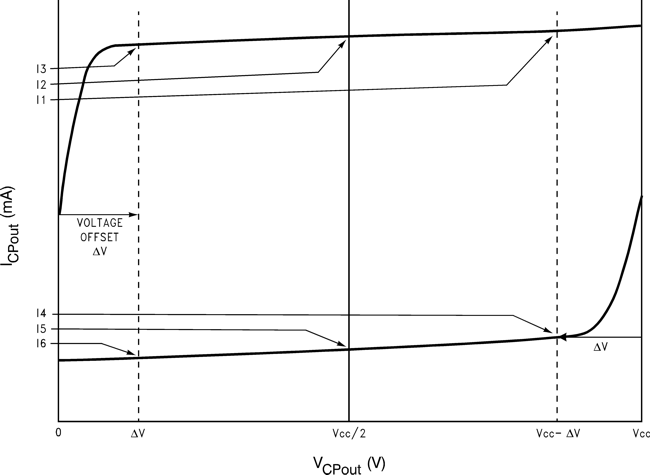 Figure 4. Charge-Pump Current
Figure 4. Charge-Pump Current
I1 = Charge-Pump Sink Current at VCPout = VCC – ΔV
I2 = Charge-Pump Sink Current at VCPout = VCC / 2
I3 = Charge-Pump Sink Current at VCPout = ΔV
I4 = Charge-Pump Source Current at VCPout = VCC – ΔV
I5 = Charge-Pump Source Current at VCPout = VCC / 2
I6 = Charge-Pump Source Current at VCPout = ΔV
ΔV = Voltage offset from the positive and negative supply rails. Defined to be 0.5 V for this device.
7.1.1 Charge-Pump Output Current Magnitude Variation vs Charge-Pump Output Voltage
Use Equation 1 to calculate the charge-pump output current variation versus the charge-pump output voltage.
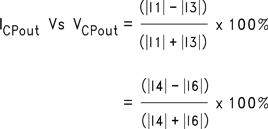
7.1.2 Charge-Pump Sink Current vs Charge-Pump Output Source Current Mismatch
Use Equation 2 to calculate the charge-pump sink current versus the source current mismatch.

7.1.3 Charge-Pump Output Current Magnitude Variation vs Temperature
Use Equation 3 to calculate the charge-pump output current magnitude variation versus the temperature.
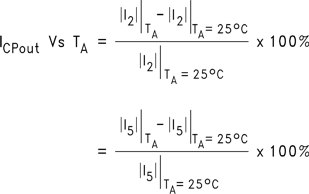
7.2 Differential Voltage Measurement Terminology
The differential voltage of a differential signal can be described by two different definitions causing confusion when reading data sheets or communicating with other engineers. This section addresses the measurement and description of a differential signal so that the reader can understand and discern between the two different definitions when used.
The first definition used to describe a differential signal is the absolute value of the voltage potential between the inverting and noninverting signal. The symbol for this first measurement is typically VID or VOD depending on if an input or output voltage is being described.
The second definition used to describe a differential signal is to measure the potential of the noninverting signal with respect to the inverting signal. The symbol for this second measurement is VSS and is a calculated parameter. Nowhere in the IC does this signal exist with respect to ground, it only exists in reference to its differential pair. VSS can be measured directly by oscilloscopes with floating references, otherwise this value can be calculated as twice the value of VOD as described in the first description.
Figure 5 shows the two different definitions side-by-side for inputs and Figure 6 shows the two different definitions side-by-side for outputs. The VID and VOD definitions show VA and VB DC levels that the noninverting and inverting signals toggle between with respect to ground. VSS input and output definitions show that if the inverting signal is considered the voltage potential reference, the noninverting signal voltage potential is now increasing and decreasing above and below the noninverting reference. Thus the peak-to-peak voltage of the differential signal can be measured.
VID and VOD are often defined as volts (V) and VSS is often defined as volts peak-to-peak (VPP).
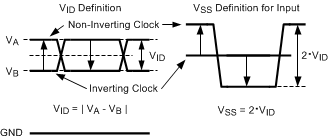 Figure 5. Two Different Definitions for Differential Input Signals
Figure 5. Two Different Definitions for Differential Input Signals
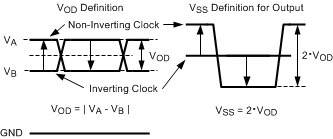 Figure 6. Two Different Definitions for Differential Output Signals
Figure 6. Two Different Definitions for Differential Output Signals
Refer to AN-912 Common Data Transmission Parameters and their Definitions (SNLA036) for more information.